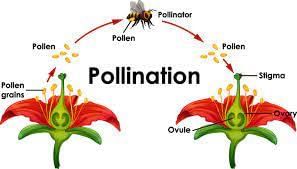Modes of Reproduction | Agriculture Optional for UPSC PDF Download
Modes of Reproduction in Plants
 The mode of reproduction in plants plays a crucial role in shaping their genetic makeup and determining their characteristics. If we examine a plant, we can identify various components. These components fall into two main categories: vegetative parts, which encompass leaves, roots, and stems, and reproductive parts, primarily represented by flowers. Flowers play a vital role in the reproductive process of plants. Within a flower, there can be male, female, or both male and female reproductive organs. When these male and female components interact, their gametes combine, leading to the formation of fruits containing seeds. These seeds, when germinated, give rise to new plants. It's worth noting that even the vegetative parts of plants have the potential to generate new plants.
The mode of reproduction in plants plays a crucial role in shaping their genetic makeup and determining their characteristics. If we examine a plant, we can identify various components. These components fall into two main categories: vegetative parts, which encompass leaves, roots, and stems, and reproductive parts, primarily represented by flowers. Flowers play a vital role in the reproductive process of plants. Within a flower, there can be male, female, or both male and female reproductive organs. When these male and female components interact, their gametes combine, leading to the formation of fruits containing seeds. These seeds, when germinated, give rise to new plants. It's worth noting that even the vegetative parts of plants have the potential to generate new plants.
The modes of plant reproduction can be majorly classified as:
- Asexual mode of reproduction
- Sexual mode of reproduction
Asexual Reproduction
This method of reproduction allows plants to generate new plants without involving the male and female reproductive components, leading to the absence of fruit and seed production.
Asexual reproduction in plants encompasses several different forms:
- Vegetative Propagation: This process involves the development of new plants from a part of the parent plant's body. It can occur naturally or be induced through artificial methods. For instance, onion bulbs reproduce naturally, while rose and banana plants are propagated artificially.
- Budding: In this form of asexual reproduction, new plants sprout from outgrowths or buds on the parent plant.
- Fragmentation: New plants are created from fragments or pieces of the parent plant.
- Apomixis: Apomixis is a type of asexual reproduction in which seeds are produced, and embryos develop without the fusion of male and female gametes. Citrus trees, for example, commonly employ this method for asexual reproduction using their seeds.
Sexual Reproduction
This form of reproduction involves generating new plants through the development of embryos resulting from the fusion of male and female gametes. In sexual reproduction, the fusion of male and female gametes leads to the formation of fruits containing seeds, which subsequently give rise to new plants.
A flower, the reproductive component of a plant, can be either unisexual or bisexual. The stamen is the male reproductive part, while the pistil is the female reproductive part of a flower.
Sexual reproduction consists of three stages:
- Pollination: This is the process by which pollen grains are transferred, either within the same flower or between flowers of different plants, from the anther to the stigma. There are two types of pollination, self-pollination (within the same flower) and cross-pollination (between different flowers).
- Zygote Formation: After the pollen grains have been transferred, the male gamete travels through the pistil's style to reach the ovary. Here, the male gamete fuses with the female gamete, resulting in the formation of a zygote.
- Fruit and Seed Formation: Following fertilization, the zygote develops into an embryo. Simultaneously, the ovary transforms into a fruit, and the ovules develop into seeds.
|
52 videos|224 docs
|
















